In recent years, wood plank ceilings have become increasingly popular in interior design over the past few years. This style involves covering and enhancing the ceiling with wooden planks to give any room a cozy and welcoming feel.
Wood plank ceilings offer a rustic, natural aesthetic that provides residential and commercial interiors personality and charm.
This blog aims to offer wood plank ceiling ideas to suit various tastes and preferences, whether you’re looking for inspiration for a cozy farmhouse kitchen, a modern industrial loft, or a traditional living room.
You’ll have various original suggestions and information at your disposal by the blog’s conclusion to aid you in making wise choices when it comes to incorporating wood plank ceilings into your interior design projects.
So let’s begin this thrilling journey and learn about the elegance and adaptability of wood plank ceiling ideas.
Benefits of Wood Plank Ceilings
A room’s overall ambiance can be greatly improved by installing wood plank ceilings because they have a warm, natural aesthetic appeal.
A warm and inviting atmosphere can be produced by the wood’s rich tones, distinctive grain patterns, and warmth. The organic and calming feel of timber creates a connection between the indoor and outdoor environments, bringing a sense of nature inside.
Wood plank ceilings are notable for their ability to complement a variety of interior design styles. Wood planks can adapt and improve the overall aesthetic whether it is a rustic, traditional, modern, or contemporary design.
Wood plank ceilings can add depth and texture to a space, adding dimension and visual interest. A visually appealing and dynamic ceiling is made possible by the variations in wood grain patterns that result from natural aging and the unique qualities of each plank.
A captivating visual effect can be produced by the interaction of light and shadow on the textured surface of the wood, giving the area depth and personality.
The acoustic qualities of wood plank ceilings are another benefit, as they can enhance a room’s sound insulation. Wood can dampen and absorb sound, which lessens reverberation and echo.
This can improve the acoustics of a location, making it more enjoyable for activities like listening to music or having conversations. Ceilings made of wood planks can lessen noise transfer between spaces.
Types of Wood Plank Ceilings
Tongue and Groove
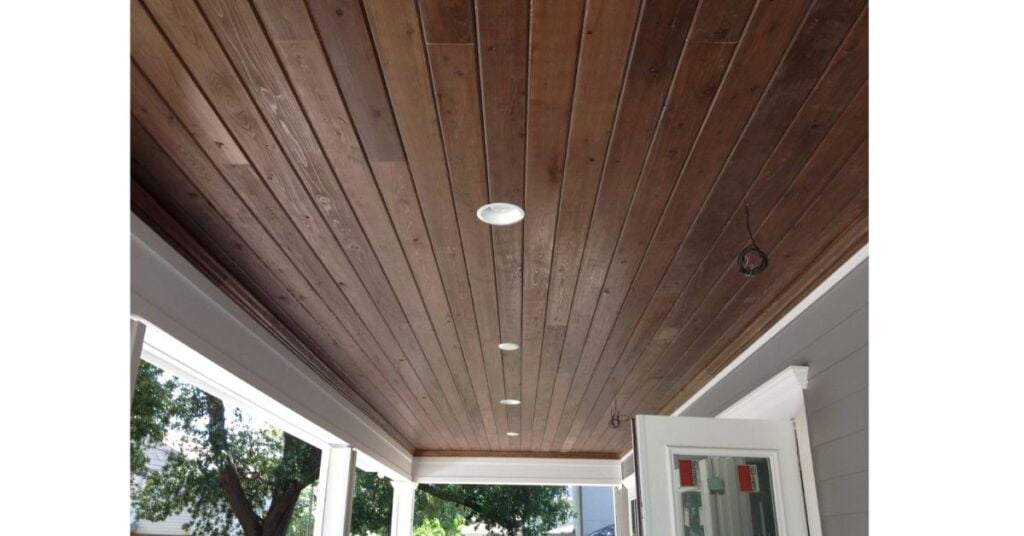
A type of wood plank ceiling known as tongue and groove has edges that are made to fit together.
The “tongue” is a protruding edge on one side of the plank, and the “groove” is a corresponding groove on the other side this layout creates a tight, seamless fit between the planks, giving the appearance of uniform and polished surfaces.
The following are the benefits of tongue and groove:
- aesthetic appeal and a clean appearance with no discernible gaps between planks.
- Because of the interlocking pattern, stability and toughness are improved.
- superior to other installation methods in terms of resistance to moisture and expansion/contraction.
A few guidelines and considerations should be kept in mind when installing a tongue and groove wood plank ceiling:
- To support the weight of the planks, make sure the substructure or existing ceiling is solidly built.
- To reduce expansion or contraction after installation, acclimatize the wood planks to the room’s humidity levels before installation.
- Depending on the requirements of the room, if a vapor barrier or insulation is required, install them.
- The planks should be fastened to the ceiling with adhesive or a pneumatic nailer.
- To ensure a tight fit and accurate alignment, carefully measure and cut the planks.
Tongue and groove wood plank ceilings come in a variety of colors and finishes to suit various design tastes. Examples comprise:
- natural or stained finishes that bring out the natural beauty of the wood.
- painted surfaces with contrasting or complementary colors to the decor of the room.
- Whitewashed or aged finishes for a coastal or rustic look.
- darker finishes for a more opulent or classic appearance.
Shiplap
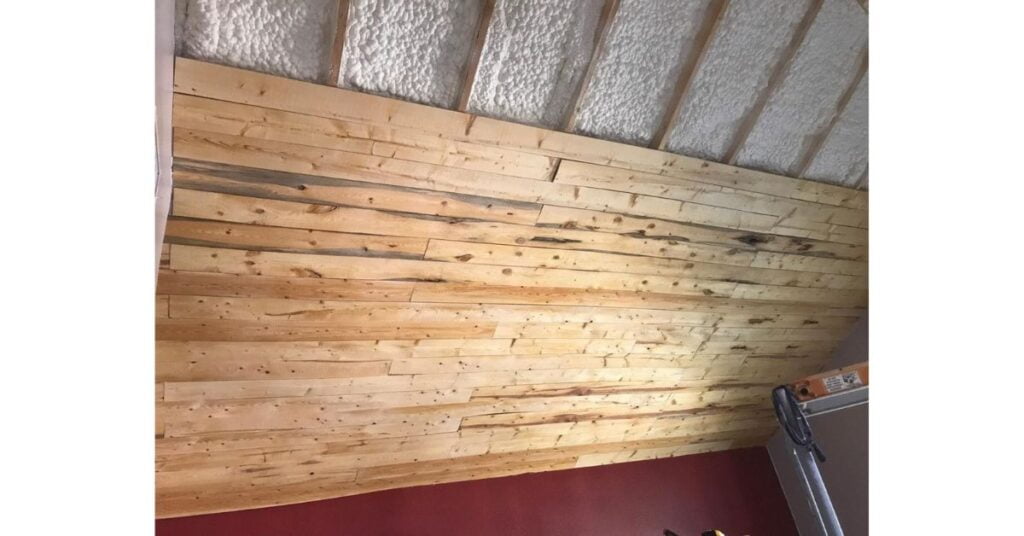
A type of wood plank ceiling known as shiplap is distinguished by its overlapping pattern.
Each plank has a tongued edge on one side and a rabbeted or grooved edge on the other, which enables the planks to fit together tightly.
The planks are arranged in an overlapping pattern that produces distinct horizontal lines and shadow gaps.
Shiplap is renowned for its casual and seaside style. It gives a room charm and personality, evoking traditional farmhouse or beach cottage designs.
Clean lines and the texture of the overlapping planks create a space that is both visually appealing and warm.
Installing shiplap can be done in a variety of ways and patterns
- The most typical installation method, where the planks are parallel to the ceiling, is horizontal installation.
- A vertical installation can give a space a distinct and elongating effect.
- A more contemporary touch and visual interest can be added by using diagonal or herringbone patterns.
Different wood species and finishes for shiplap are available to suit different design preferences:
- Pine is preferred due to its low cost and distinctive natural grain patterns.
- Because cedar naturally resists insects and decay, it can be used in humid environments.
- Shiplap’s rustic appeal can be enhanced by using reclaimed or distressed wood.
- Finishes come in various colors and range from stained or natural wood tones.
Reclaimed Wood
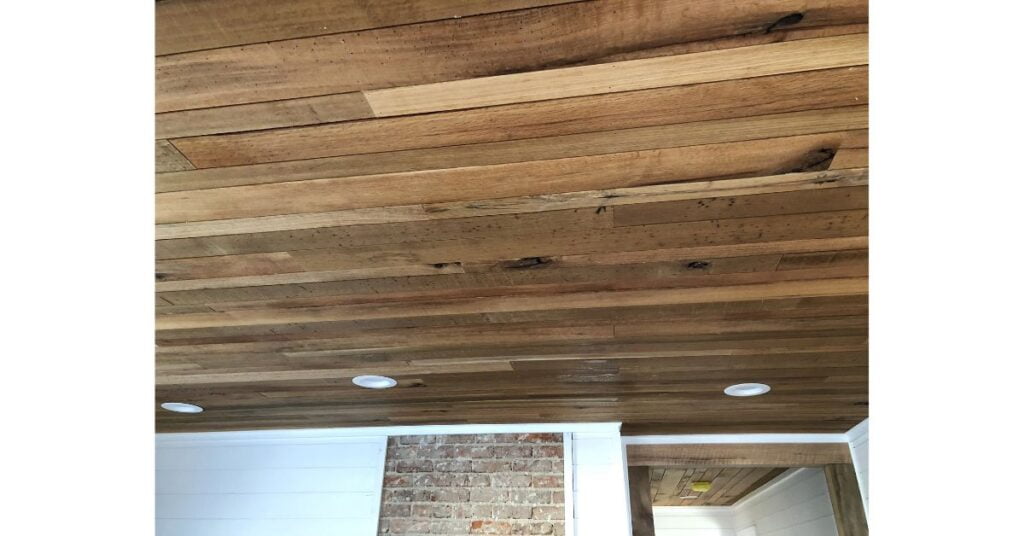
Ceilings made of reclaimed wood planks are extremely distinctive and healthy for the environment.
Reclaimed wood that has been recovered from old buildings, barns, or other structures to be utilized for another purpose.
By reusing materials that would otherwise be thrown away, it provides a sustainable alternative.
A room gains rich history and character when reclaimed wood is used. A unique aesthetic is produced by the weathered patina, nail holes, saw marks, and other flaws.
Any space can benefit from the coziness, sincerity, and nostalgic quality of reclaimed wood.
Finding and preparing reclaimed wood planks for a ceiling requires that you:
- To ensure quality and authenticity, look for reputable suppliers who focus on reclaimed materials.
- Select wood species that are compatible with your design preferences and the intended application.
- By taking out the nails, smoothing out the edges, and, if necessary, treating the wood for pests or mold, you can clean and prepare the wood.
- To increase the wood’s toughness and guard against further wear, think about adding a clear sealant or finish.
There are numerous ways to install reclaimed wood planks, including:
- For a seamless appearance, use traditional nail or adhesive installation.
- adjusting the planks’ lengths or widths to produce a more rustic or eclectic look.
- combining various types of wood or reclaimed wood with fresh materials for a unique contrast.
Exposed Beam Ceilings
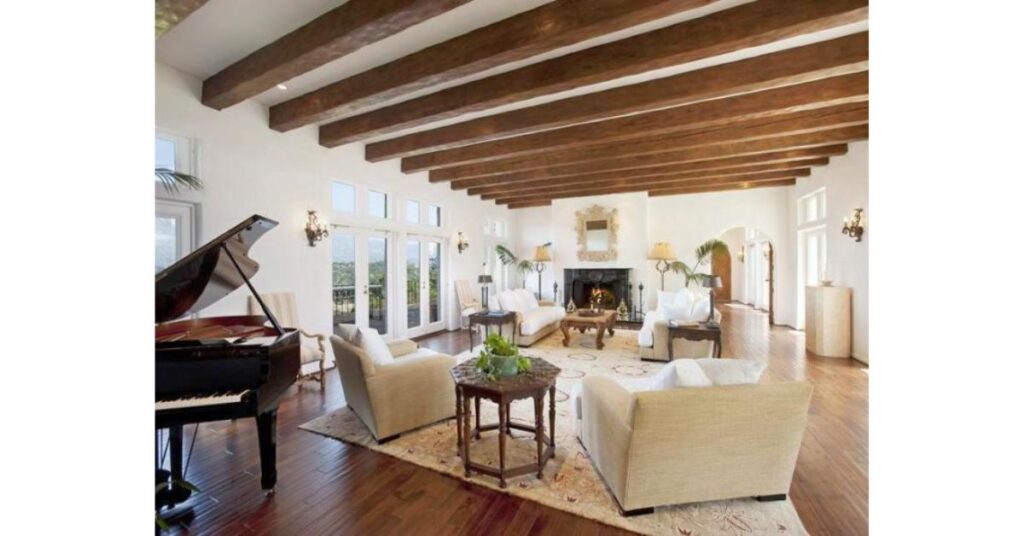
The structural elegance and architectural interest of wooden beams is displayed in ceilings with exposed beams.
Beams are left exposed on the ceiling rather than completely covered, giving a room a unique focal point. Different wood species, each with unique aesthetic qualities, can be used to create the beams.
For exposed beams, various wood species can be used, allowing for a variety of styles:
- Oak beams’ pronounced grain patterns and durability give them a timeless, classic appearance.
- The warm, reddish-brown color of Douglas fir beams gives a rustic and organic appearance.
- The distinctive smell, inherent resistance to insects and decay, and lighter appearance of cedar beams are all advantages.
- Beams made of reclaimed wood give a room a sense of history and character.
A harmonious and cohesive aesthetic can be produced by combining exposed beams and wood plank ceilings. Think about the following:
- Pick planks that go well with the design and hue of the beams.
- To maintain a balanced and aesthetically pleasing arrangement, make sure the planks and beams are properly spaced and aligned.
- Include lighting fixtures or accents that draw attention to the ceiling’s wood planks and beams.
Design concepts for various room types:
- Living room: Use exposed beams and a wood plank ceiling to create a warm, inviting atmosphere that is ideal for gathering and relaxing.
- Kitchen: Incorporate beams and a ceiling to add character and charm while combining the coziness of wood with the functionality of a well-designed kitchen.
- Create a calm and tranquil retreat in the bedroom by incorporating wood plank ceilings and
Remember, each type of wood plank ceiling has a special charm of its own, and choosing the best one depends on your desired aesthetic, budget, and overall design objectives.
Wood Finishes and Stains
Choosing the right finish for wood plank ceilings:
For wood plank ceilings, picking the right finish is essential because it not only improves the aesthetic appeal but also shields the wood from moisture, UV rays, and wear. The finish adds durability and longevity to the ceiling while enhancing the natural beauty of the wood.
Different types of finishes for wood plank ceilings include:
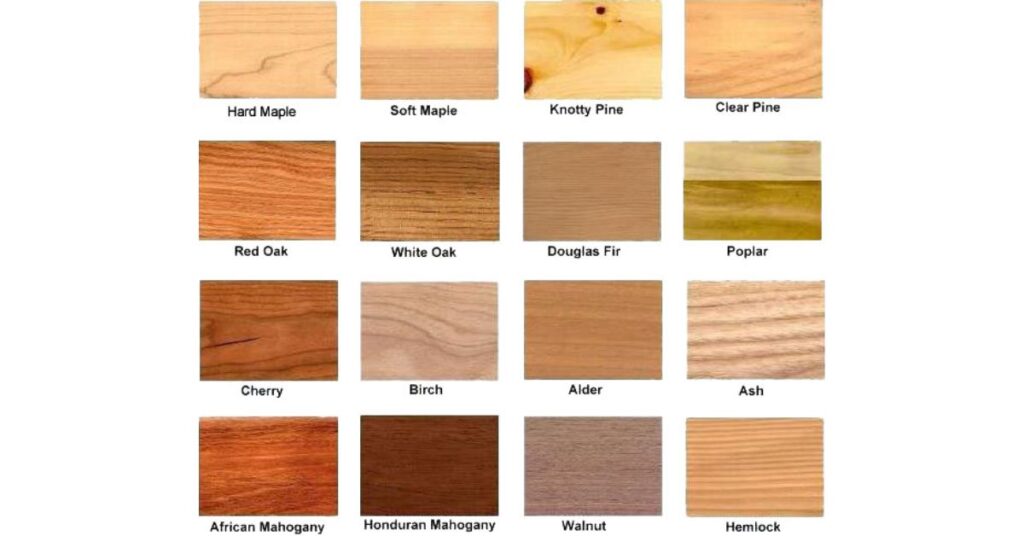
Clear Coatings: Clear coatings like varnish, polyurethane, or lacquer offer protection while letting the wood’s inherent beauty and grain show through. They are available in various sheen types, ranging from matte to high gloss.
Stains: Wood stains give the wood color while still allowing the grain pattern to be seen. They can be transparent, semi-transparent, or opaque and come in a variety of colors. The natural tones of the wood can be enhanced by stains or changed to produce a particular desired color.
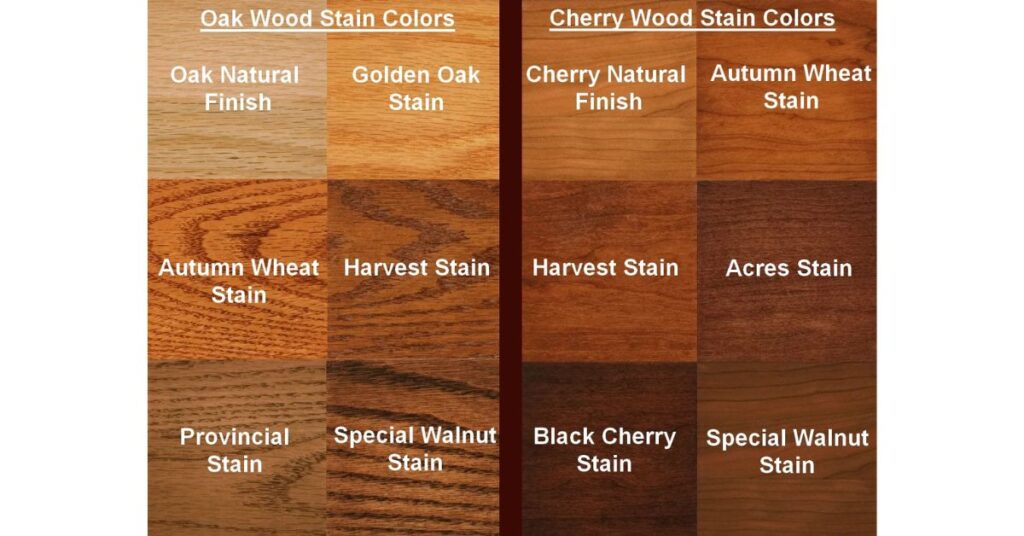
The ceiling made of wood planks offers the most color variety when painted. It can completely alter the ceiling’s appearance by hiding the wood’s natural grain and texture. Paint offers a uniform, slick surface, and can be matched to the room’s color scheme or used to create a contrasting accent.
Tips for selecting the appropriate finish:
Consider your desired aesthetic when choosing your desired look. Choose a clear finish if you want the wood to look as natural as possible. Stains can be a great option if you want a specific color or to emphasize the grain. Consider painting the wood plank ceiling for a more striking or distinctive appearance.
Maintenance: The upkeep requirements vary depending on the finish. To maintain their protective qualities, clear finishes might need to be reapplied from time to time. Over time, stains may fade and require touch-ups. Painted surfaces might need to be painted again every so often. When selecting the finish, take your willingness to put time and effort into maintenance into account.
Compatibility: Ensure the chosen finish is suitable for the wood species used for the plank ceiling. The final appearance may vary depending on how differently different wood species absorb finishes. Test the finish on a small sample of the wood to see how it reacts before applying it to the entire ceiling.
Lighting and Room Size: Be aware that finishes can change how a room appears to be lit. Darker finishes absorb more light and produce a cozier atmosphere, while lighter finishes tend to reflect more light and can make a space appear brighter and larger. When choosing a finish, take into account the size and natural lighting of the room.
Examples of finished wood plank ceilings for inspiration:
Clear Finish: A clear varnish can highlight the natural warmth and beauty of wood, giving it a timeless and opulent appearance.
Stained Finish: A ceiling made of wood planks with a rich, dark walnut stain can add sophistication and depth while still allowing the natural grain to show through.
Painted Finish: A white painted wood plank ceiling can produce a light and airy atmosphere that is ideal for farmhouse or coastal-style interiors.
Weathered Finish: A wood plank ceiling with a weathered or distressed finish can give the room a rustic, aged charm while also adding character and visual interest.
Keep in mind that the finish you choose should complement your taste, the room’s desired atmosphere, and the overall design concept. Before applying the finish to the entire wood plank ceiling, be sure to take into account the required maintenance and test it on a small sample.
Maintenance and Care
To keep their beauty and longevity, wood plank ceilings require maintenance and care. The following advice will help you take good care of your wood plank ceiling:
Regular Cleaning: Use a soft cloth, feather duster or a gentle hoover attachment to regularly dust your wood plank ceiling. This keeps the surface clean and improves its appearance by preventing the accumulation of dust and dirt.
Avoid Excessive Moisture: Because wood is prone to damage from moisture, it is crucial to avoid excessive moisture contact. Wipe up spills promptly and avoid excessive humidity levels in the room.
In places that are susceptible to moisture, like bathrooms or kitchens, use proper ventilation.
Design Inspiration and Tips
The following are some beautiful rooms with wood plank ceilings for inspiration.
Living Room: A large living room with a vaulted wood plank ceiling makes the space feel opulent and welcoming. Cozy furniture, a stone fireplace, and the wood’s inherent warmth combine to give the room a rustic appeal.
Kitchen: A white-painted wood plank ceiling in a farmhouse-style kitchen adds a touch of rustic elegance. It produces a warm and inviting atmosphere when combined with open shelving, vintage-inspired lighting fixtures, and distressed wood cabinetry.
Bedroom: A peaceful bedroom exudes a calming and organic feel. The wood plank ceiling is stained in a warm, natural tone. The wood ceiling creates a tranquil retreat when combined with soft textures, neutral bedding, and modern decor.
Dining area: A contemporary dining area with a smooth wood plank ceiling finished in a dark stain adds sophistication and depth. The space is made stylish and elegant by the linear pattern of the ceiling, which goes well with modern furnishings and simple design elements.
Including wood plank ceilings in various architectural styles:
Choose rustic wood plank ceilings with weathered or natural finishes for a farmhouse look. For a cozy and welcoming farmhouse aesthetic, pair them with vintage-inspired furniture, weathered finishes, and cozy textiles.
Modern: Opt for smooth-finished, clean-lined wood plank ceilings. For a modern appearance, think about using lighter wood tones or painting the planks a neutral color. For a modern look, combine the wood ceiling with simple furnishings and striking accents.
Scandinavian: For a design that is inspired by Scandinavia, use light and organic wood tones. Use clear or whitewashed ceilings made of light-colored wood planks. Keep the area uncluttered and open, use only a few pieces of furniture, and emphasize natural light and simplicity.
Suggestions for generating visual appeal:
Try experimenting with different patterns, like herringbone or chevron, on the wood plank ceiling to add visual interest and make a special focal point in the space.
To make the wood plank ceiling stand out, use contrasting colors on the walls and ceiling. For instance, contrast a ceiling with dark stains with lighter-colored walls, or the opposite.
Lighting: To draw attention to the wood plank ceiling, use strategic lighting. To illuminate the ceiling and produce a cozy and welcoming atmosphere, install track lighting, pendant lights, or recessed lighting.
Taking into account the space’s dimensions, ceiling height, and atmosphere:
Lighter-colored wood plank ceilings in smaller spaces can help give the impression of more space. Larger rooms can feel more intimate and cozy with darker finishes.
Ceiling Height: To visually lower the ceiling and give a room a more intimate feel, use wider planks or expose beams in rooms with high ceilings. Lighter-colored finishes and narrower planks can help give the impression of height in rooms with lower ceilings.
Ambiance overall: The wood plank ceiling should complement the intended ambiance of the space. Think about the overall look, color scheme, and atmosphere you want to create. A wood plank ceiling can improve the desired ambiance by bringing warmth and character to the room.
Conclusion
Wood plank ceilings have many advantages, including their warm and natural aesthetic appeal, adaptability to various interior design aesthetics, capacity to add texture and depth to a space, and acoustic qualities that enhance sound insulation.
They create a warm and welcoming atmosphere while bringing a bit of nature indoors.
As you start work on your upcoming interior design project, think about the options that wood plank ceilings may present. Explore the various finishes, designs, and lighting choices available to create a distinctive and alluring space by letting your creativity run free.
Wood plank ceilings can be a versatile and eye-catching addition to any design scheme, whether it’s a farmhouse, modern, Scandinavian, or any other.
FAQs
What are some popular wood plank ceiling ideas?
Rustic Farmhouse, Modern and Minimalist, Coastal or Beachy
Are wood plank ceilings suitable for both high and low ceiling heights?
Yes, wood plank ceilings can work well with different ceiling heights.
How do wood plank ceilings compare to other ceiling materials?
Wood plank ceilings offer unique warmth, character, and natural beauty that can’t be replicated by other ceiling materials. They provide a timeless appeal and a connection to nature, enhancing the overall ambiance of a space. Compared to other materials like drywall or metal, wood plank ceilings also have better sound insulation properties and can bring a sense of texture and depth to a room.
